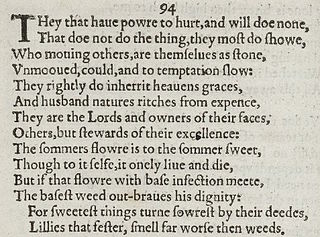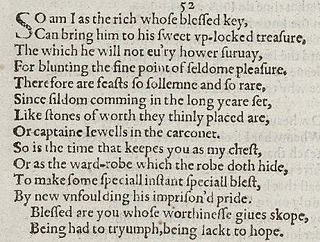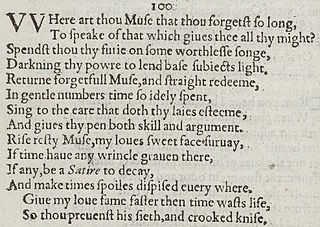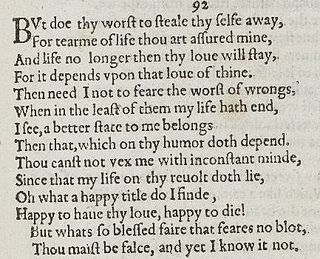| Sonnet 93 | |||||||
|---|---|---|---|---|---|---|---|
 Sonnet 93 in the 1609 Quarto | |||||||
| | |||||||
| |||||||
Sonnet 93 is one of 154 sonnets written by the English playwright and poet William Shakespeare. It is a member of the Fair Youth sequence, in which the poet expresses his love towards a young man.
| Sonnet 93 | |||||||
|---|---|---|---|---|---|---|---|
 Sonnet 93 in the 1609 Quarto | |||||||
| | |||||||
| |||||||
Sonnet 93 is one of 154 sonnets written by the English playwright and poet William Shakespeare. It is a member of the Fair Youth sequence, in which the poet expresses his love towards a young man.
Continuing the alarmed discovery at the end of Sonnet 92, the poet here explores what it would be like to be living a life in which the young man's deceiving of him is simply unknown to the poet. Instead of dying at the moment of discovery of falsity, the poet now lives 'like a deceived husband'.
The vocabulary of this sonnet repeats terms that appear throughout the sequence, and gives readers a sense of the sequence feeding off itself, finding source in its own prior utterances.
Sonnet 93 features 'face' twice (15 times in the whole sequence), 'looks' twice (12 times in the whole sequence), and 'love' also twice ('love', unsurprisingly appears frequently, 172 times, throughout the Q1609 sequence).
Remarkably, the poet imagines himself as being like a 'deceived husband': directly relating his friendship with the young man to marriage. The sonnet ends with the allusion to 'Eve's apple', making the 'deceived husband', the poet in line 2, into a version of Adam, and the betrayal into a version of the Fall. Otherwise, religious references in the poem seem facile or inflated: 'heaven in thy creation did decree' etc. Readers are confronted again to the exaggerated sense of betrayal expressed in these sonnets - what kind of claim could the poet have thought he had over the young man?
The final line of the sonnet expresses the poet's uneasy bafflement: the young man's beautiful 'show' is completely opaque, he will only ever seem beautiful to the poet, his heart's duplicitous inner 'workings' will never betray themselves in 'moods and frowns and wrinkles strange'. That triad of terms, redundant in expression again suggests that Shakespeare in not writing at high pressure in this sonnet. 'Workings' is a rare word in Shakespeare, only here and in the no doubt near contemporary Henry IV Part 2. The unreadable, always beautiful face of the young man looks forward in the Q1609 sequence to the face of the 'woman coloured ill' in the final group of so-called 'Dark Lady' sonnets, where face and deeds match blackness, rather than the young man's mismatch of lovely appearance and morally ugly behaviour.
This sonnet perhaps struggles to get the attention of experienced readers of the sequence, as it is followed by a far more striking sonnet, 94, and such readers might always be tempted to turn to the utterly unformulaic sonnet that follows.
Sonnet 93 is notionally an English or Shakespearean sonnet. The English sonnet has three quatrains, followed by a final rhyming couplet. However, in terms of its syntactical units, sonnet 93 breaks down into 6 lines, another 6, then the closing couplet. It still follows the typical rhyme scheme of the form, ABAB CDCD EFEF GG, and is composed in iambic pentameter, a type of poetic metre based on five pairs of metrically weak/strong syllabic positions. The 5th line exemplifies a regular iambic pentameter:
× / × / × / × / × / For there can live no hatred in thine eye, (93.5)
The meter demands a few variant pronunciations: line 2's "deceivèd" has three syllables, [2] and line 9's "heaven" functions as one. [3]

Sonnet 94 is one of 154 sonnets written by the English playwright and poet William Shakespeare. It is a member of the Fair Youth sequence, in which the poet expresses his love towards a young man.

Shakespeare's Sonnet 34 is included in what is referred to as the Fair Youth sequence, and it is the second of a briefer sequence concerned with a betrayal of the poet committed by the young man, who is addressed as a personification of the sun.

Sonnet 49 is one of 154 sonnets written by the English playwright and poet William Shakespeare. It is a member of the Fair Youth sequence, in which the poet expresses his love towards a young man.

Sonnet 50 is one of 154 sonnets written by the English playwright and poet William Shakespeare. It is a member of the Fair Youth sequence, in which the poet expresses his love towards a young man. It is continued in Sonnet 51.

Sonnet 51 is one of 154 sonnets written by the English playwright and poet William Shakespeare. It is part of the Fair Youth sequence, in which the poet expresses his love towards a young man. It is a continuation of the argument from Sonnet 50.

Sonnet 52 is one of 154 sonnets written by the English playwright and poet William Shakespeare. It is a member of the Fair Youth sequence, in which the poet expresses his love towards a young man.

Sonnet 61 is one of 154 sonnets written by the English playwright and poet William Shakespeare. It is a member of the Fair Youth sequence, in which the poet expresses his love towards a young man.

Sonnet 100 is one of 154 sonnets written by the English playwright and poet William Shakespeare. It is a member of the Fair Youth sequence, in which the poet expresses his love towards a young man.

Sonnet 98 is one of 154 sonnets written by the English playwright and poet William Shakespeare. It is a member of the Fair Youth sequence, in which the persona expresses his love towards a young man. It is the second of a group of three sonnets to treat a separation of the speaker from his beloved.

Sonnet 92 is one of 154 sonnets written by the English playwright and poet William Shakespeare. It is a member of the Fair Youth sequence, in which the poet expresses his love towards a young man.

Sonnet 70 is one of 154 sonnets written by the English playwright and poet William Shakespeare. It is a member of the Fair Youth sequence, in which the poet expresses his love towards a young man.

Sonnet 72 is one of 154 sonnets published by the English playwright and poet William Shakespeare in 1609. It is one of the Fair Youth Sequence, which includes Sonnet 1 through Sonnet 126.

Sonnet 107 is one of 154 sonnets written by the English playwright and poet William Shakespeare. It is a member of the Fair Youth sequence, in which the poet expresses his love towards a young man.
Sonnet 89 is one of 154 sonnets written by the English playwright and poet William Shakespeare. It is a member of the Fair Youth sequence, in which the poet expresses his love towards a young man.

Sonnet 90 is one of 154 sonnets written by the English playwright and poet William Shakespeare. It is a member of the Fair Youth sequence, in which the poet expresses his love towards a young man.

Sonnet 95 is one of 154 sonnets written by the English playwright and poet William Shakespeare. It is a member of the Fair Youth sequence, in which the poet expresses his love towards a young man.

Sonnet 96 is one of 154 sonnets written by the English playwright and poet William Shakespeare. It is a member of the Fair Youth sequence.

Sonnet 103 is one of 154 sonnets written by the English playwright and poet William Shakespeare. It is a member of the Fair Youth sequence, in which the poet expresses his love towards a young man.
Sonnet 120 is one of 154 sonnets written by the English playwright and poet William Shakespeare. It's a member of the Fair Youth sequence, in which the poet expresses his love towards a young man.

Sonnet 122 is one of 154 sonnets written by the English playwright and poet William Shakespeare, and first published in 1609. It is a member of the Fair Youth sequence, in which the poet expresses his love towards a young man. Although the relationship started exuberantly in Sonnet 18 by now it has given way to an almost defensive tone. The poet justifies giving away or losing a notebook ("tables") given him by the youth to record shared events by saying that his memories of them are stronger.